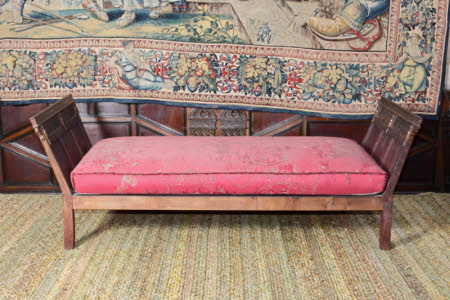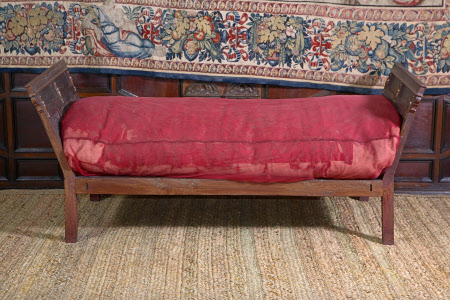The so-called 'Hardwick Couch of State'
Category
Furniture
Date
circa 1625 - circa 1640
Materials
Oak and elm, probably later pine seat rails, paint and gilt, the covers of silk damask
Measurements
95 x 217 x 102 cm
Place of origin
England
Order this imageCollection
Hardwick Hall, Derbyshire
NT 1127775
Summary
This rare English Couch (or chair) of State is one of only two of this type known. The other, in the Victoria & Albert Museum (W.57:1 to 5-1953) has had one end removed, and has been later painted, but is clearly a related example. There is some doubt as to the date of this couch - it was once thought to be Elizabethan - but the coat of arms of Cavendish 'sable, three harts' heads cabossed, argent, attired or' impaling that of Bruce of Kinloss, 'or, a saltire and chief gules, on a canton argent a lion rampant azure, armed and langued of the second' must refer to a date after the marriage of Christian Bruce (1595 - 1675) to William Cavendish, 2nd Earl of Devonshire (1590 - 1628), which took place (much to William Cavendish's horror, for Christian was only twelve) in 1608. The coat of arms is beneath an Earl's (or Countess') coronet, however, so a terminus ante quem is 1625, when the 2nd Earl assumed his title. He died in 1628. Strictly speaking, as a widow Christian should have displayed her arms on a lozenge, and without the coronet, but since this was not always enforced, it is possible that the arms were painted after 1628. Stylistically, the couch could date from any part of the second quarter of the 17th century, and so a date of c. 1625 - c.1640 for its production seems most likely. This couch was more than just a piece of seat furniture, but served a ritual purpose. Listed in the Long Gallery in the inventory of 1764, it was shown in the Long Gallery in a 1775 drawing of Samuel Hieronymus Grimm as beneath a canopy with flanking stools, suggesting that it was used as a throne. The Hardwick Couch is of oak and elm, with later pine seat rails, and now displayed with later upholstery, although the original silk damask cover and valances are visible in illustrations from earlier in the century. The couch has a pair of sloping paneled ends, set at an angle to the plain stile legs to which they descend. Of two slender panels over three rectangular panels, which are spaced by applied split baluster mouldings. The toprail to each end with applied or moulded cap, and fitted to the underside of each end with scrolling spandrels. The ends painted in red, probably to simulate or imitate the red velvet upholstery of coeval (more luxurious) seat furniture of state, like the state chairs at Knole in Kent [i.e. NT 129463]. Further decoration, probably to simulate embroidery, comprises line-carved and coloured (in green, white and yellow) flowers within delicate foliate roundels, and with the armorial achievements described above. The splits balusters retain traces of gilt. It is possible that some of the paint and the couch's pine seat rails are later.
Provenance
Shown under a canopy in a drawing by Samuel Hieronymous Grimm in 1775. Note that only three 'roundels' to each frieze panel and no coat of arms. Beneath the canopy in the Long Gallery in David Cox's 1831 watercolour. By descent until, following the death of Edward William Spencer Cavendish, 10th Duke of Devonshire (1895 - 1950), Hardwick Hall and its contents were accepted by HM Treasury in part payment of death duties and transferred to the National Trust, in 1959.
References
Rowell 2006: Christopher Rowell, 'A Set of Early Seventeenth-Century Crimson Velvet Seat Furniture at Knole: New Light on the "Knole Sofa"', Furniture History XLII (2006): 27-52, pp. 34 - 35 P. Macquoid & R. Edwards, 'The dictionary of English Furniture' (1986, softback edition, 3 volumes), pp. 134 - 136 Rowell, Christopher, 'The 'Bachelor' 6th Duke of Devonshire and Hardwick', in David Adshead and David Taylor, Hardwick Hall: A Great Old Castle of Romance (2016), 257 - 8

